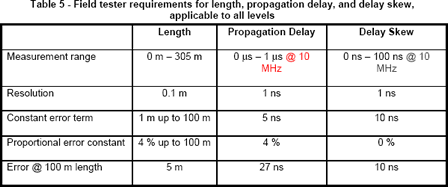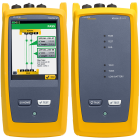Network Cable Propagation Delay
Propagation delay, or delay, is a measure of the time required for a signal to propagate from one end of the circuit to the other. Network propagation delay is measured in nanoseconds (nS). Typical propagation delay for category 5e UTP is a bit less than 5 nS per meter (worst case allowed is 5.7 nS/m). A 100 meter cable might have delay as shown below.

Propagation delay is the principle reason for a length limitation in LAN cabling. In many networking applications, such as those employing CSMA/CD, there is a maximum propagation delay that can be supported without losing control of communications.
Nominal Velocity of Propagation (NVP) on the other hand, is different. NVP refers to the inherent speed of signal travel relative to the speed of light in a vacuum (designated as a lower case c). NVP is expressed as a percentage of c, for example, 72%, or 0.72c. All structured wiring cables will have NVP values in the range of 0.6c to 0.9c.
Propagation Delay will of course change with frequency. ANSI/TIA-1152 requires field testers to make the measurement at 10 MHz.

This is also true for ISO/IEC 11801 which refers testing to IEC 61935-1 which require the measurement to be made at 10 MHz.
결과 해석
Network propagation delay measurements are relatively straightforward. Most structured wiring standards expect a maximum horizontal delay of 570 nS. If design specifications allow, higher cable propagation delay can be acceptable.
Since each pair in the network cable has its own unique twist ratio, the delay will vary in each pair. This variance (delay skew, discussed in the next section) should not exceed 50 nS on any link segment up to 100 meters. Standards require all pairs to meet the requirement. It is possible to report just the worst case pair. This will be the pair with the highest network propagation delay.
문제 해결 권장 사항
Excessive propagation delay can have only one cause: the cable is too long. If you fail propagation delay, check to ensure that the pass/fail criteria match the design specifications. If so, the cable is too long. In many cases, a cable up to 25% too long (125m for Category 5e) will still support most LAN applications. However, the installation will fail most structured wiring standards, such as those published by CENELEC, ISO/IEC, and the TIA. In some cases, if the customer insists on the location of the terminal equipment, and an excessive length cannot be avoided, you can verify other cable parameters. If they pass, you can provide information that indicates the cable meets frequency-dependent parameters but is non-compliant with overall standards due to excessive length. This provides professional results to the user while placing on them the responsibility for non-compliant cabling.







